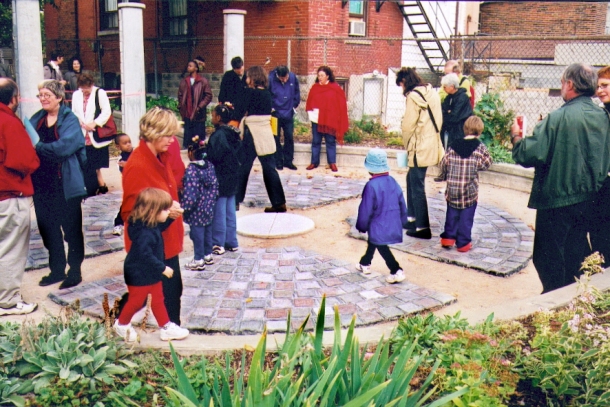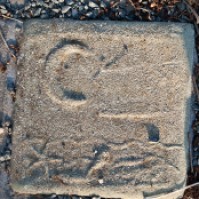Public art is art that is installed in a place where everyone has free access to it. It is meant to decorate and even define the area of its location; to create a sense of place. Some public art is community art; it relates to and reflects the community where it is situated. It is often created by local residents collaborating with professional artists. So, community art is public art that is made by the people who live where it is.
Project Manager John Devenish talks about public art:
The Community Totem
In a small corner park on Vaughan Road is an artwork called the Community Totem, created by the people who live around there. The installation grounds that little park in time as well as geography; in depth of history and in breadth of the local population.
The Totem is comprised of three tall posts facing Vaughan Road opposite a low, circular retaining wall which outlines it and offers a place to sit. Within that circle, hand-made and decorated tiles are laid out in four sections around a scored circle at the center, oriented to the four directions. Tall trees shade the circle and flowering plants and shrubs surround it. It suggests gathering, invites reflection and emanates a sense of connection and ‘groundedness’.
John describes the Community Totem (above):
A Community Marker
The Community Totem is a project generated by Art Starts, an arts organization that brings together professional artists and local residents to collaborate in creating public art projects which reflect their community. In 1998, Arts Starts’ idea was to have a millennium project that reflected this diverse Oakwood neighbourhood by having between 300 and 500 community residents participate. They began with the notion of creating a marker in a community comprised of people who share a geographic space, yet may not share a common language, interests, politics or religious beliefs. It developed through many iterations among the project organizers until the intention was refined and made site-specific. The organizers were adamant that the art be a collective expression. Not an artwork by a professional artist simply presenting local residents with a representation of themselves that they could look at – but something that was a collaboration between artist and residents and made together.
A creative team of four carried out the project. Mira Coviensky, Art Starts Program Director, and John Devenish, Project Manager, hired lead artist Reinhard Retzenstein, who had experience with community art and was established in public art. An immigrant himself, Reinhard was also interested in the flavour of this neighbourhood. He brought on board Lois Dellert, an artist expert in working with concrete and a skilled workshop facilitator.
John Devenish is a guy who gets involved, wherever he is. He relishes getting something going and getting people together to do it.  He was project coordinator and arts animator for the Community Totem – basically making sure all necessary connections were made and followed up, including sparking interest in the neighbourhood. “I always think, when you’re going to do something, make it big, make some noise. And one thing you know, if you’ve lived in this neighbourhood is, when you do make noise here, people come out to see what’s going on. And that’s a good thing; then they’re involved.” He feels a great attachment to his neighbourhood, brought up his son here and is convinced there’s no place like the former City of York. To him the idea of making a welcoming gate or totem was an expression of his pride and connection to the place as well as his assumption that others here feel as he does. “I wanted everyone’s hands in it.” He took great satisfaction in bringing the idea to fruition, getting it done. Making some noise, as he says.
He was project coordinator and arts animator for the Community Totem – basically making sure all necessary connections were made and followed up, including sparking interest in the neighbourhood. “I always think, when you’re going to do something, make it big, make some noise. And one thing you know, if you’ve lived in this neighbourhood is, when you do make noise here, people come out to see what’s going on. And that’s a good thing; then they’re involved.” He feels a great attachment to his neighbourhood, brought up his son here and is convinced there’s no place like the former City of York. To him the idea of making a welcoming gate or totem was an expression of his pride and connection to the place as well as his assumption that others here feel as he does. “I wanted everyone’s hands in it.” He took great satisfaction in bringing the idea to fruition, getting it done. Making some noise, as he says.
Vaughan Road
 Vaughan Road runs diagonally right through the former City of York and John explains why it became the location of the Community Totem. “I always wondered why Vaughan Road didn’t follow the grid and I thought well, I’ll just go to the city archives and find out. They didn’t have any info about it or any maps really, just a few drawings and some old photos of dirt roads and roads paved with logs. Vaughan used to zig-zag up the hill, it didn’t come straight up, but they couldn’t really explain it. Then when we got Na-Me-Res involved, those guys knew. They knew the Ojibway people had always used it, that it’s an old portage route that goes all the way to Lake Simcoe. Na-Me-Res is located here because of course they should be where they always were. That’s 20,000 years in the neighbourhood, as they say. The guys who use their programs got involved and the staff got involved too, and Duke Redbird, the storyteller. They put us in touch with the Tall Pines Drummers. When the Totem was finished in 2001 they came to the dedication with a shaman and they burned sweetgrass, they drummed and sang. The ceremony was very stirring because we were on Native land. That is, it is Native land.”
Vaughan Road runs diagonally right through the former City of York and John explains why it became the location of the Community Totem. “I always wondered why Vaughan Road didn’t follow the grid and I thought well, I’ll just go to the city archives and find out. They didn’t have any info about it or any maps really, just a few drawings and some old photos of dirt roads and roads paved with logs. Vaughan used to zig-zag up the hill, it didn’t come straight up, but they couldn’t really explain it. Then when we got Na-Me-Res involved, those guys knew. They knew the Ojibway people had always used it, that it’s an old portage route that goes all the way to Lake Simcoe. Na-Me-Res is located here because of course they should be where they always were. That’s 20,000 years in the neighbourhood, as they say. The guys who use their programs got involved and the staff got involved too, and Duke Redbird, the storyteller. They put us in touch with the Tall Pines Drummers. When the Totem was finished in 2001 they came to the dedication with a shaman and they burned sweetgrass, they drummed and sang. The ceremony was very stirring because we were on Native land. That is, it is Native land.”
On Vaughan Road:
The Tile Makers
The artists conceived the overall shape and concept of the project. Then it was up to members of the community to create the individual tiles that make up the mosaic circle. Local community groups hosted and participated in the tile-making workshops, including: Humewood P.S. Fair, York Health Centre, Art Starts, Oakwood Village Library, Na-Me-Res, Italian Women’s Theatre Group, Art Starts Summer Camp, the Canadian-Jamaican Association, St. Clair West Senior Centre, York Community Services, Junior Carnival and Vaughan Road Academy.
Artist Lois Dellert recalls the first workshop. “We set up our table at the Humewood School Country Fair and as soon as the gates opened we were off and running. Reinhard rolled slabs of clay for four hours non-stop while John, Starr and I worked like crazy to assist over 75 children and parents to make their own unique expressions in a clay tile.”
John remembers the workshops: “Each individual tile was meant to tell a person’s story, though of course we found that everybody’s story is bigger than one tile. But people got a chance to cast their notions or ideas of who they are, where they came from or maybe what they feel about where they’re living. And as they made their tiles they would tell their story. Bringing those stories out was to me the valuable part.”
“There’s one tile I always remember, it has a boat on it, maybe with a sail I think, and some wavy lines representing water, and I remember when they talked about arriving by ship to Canada and landing in Nova Scotia and not knowing how far it was or how they would get to Toronto, and riding the train and ‘are we there yet?’”
Stories as public art (describing the tiles):
Lois Dellert recounts memorable incidents in the community-based workshops, including “the group of hyper-active young boys who had a water fight in the basement of the library; the six-week old twins whose mother worked hard to soften the clay so she could get a good impression of her babies’ footprints; Nick who wanted help drawing a picture of his cat and his dog; the ‘herbalists’ at Vaughan Road Collegiate who needed no assistance in accurately rendering cannabis leaves; the Italian Women’s Theatre group who captured stories of their immigration to Canada; and the 90-year old at the seniors’ centre who proudly recorded the initials of each of his children.”
“After each workshop I returned home with stacks of cardboard trays containing the clay tiles made by the community residents. My job, along with the help of my assistant Alison, was to cast each and every one of them in concrete.”
The Tiles
Click here to see all the tiles.
The stories of those who have come from the four corners of the world to live here lie side by side in an installation that is one unified whole. Together they have made a place.
Lois Dellert reflects, “When placed together the individual expressions captured in the tiles told a story of the community. John’s initial inspiration of a community marker had finally been realized.” As John told all the participants when they made their tiles, “this is permanent – you can come back here, you can bring your kids, this is your story and it will always be here.” Map
 – Schuster Gindin
– Schuster Gindin
Photos by Schuster Gindin and courtesy Art Starts
For resources used in the writing of this article, thanks to Art Starts and their current and former personnel, including Tamara Haberman, Mira Coviensky, Angela Lee, Lois Dellert, and Alison Bates. And for his stories, his voice and his patience, thanks to John Devenish.
Hear John Devenish Monday to Friday from 6PM to 9PM on JAZZ.FM91
This article is part of our issue: PUBLIC SPACE/PUBLIC ART









